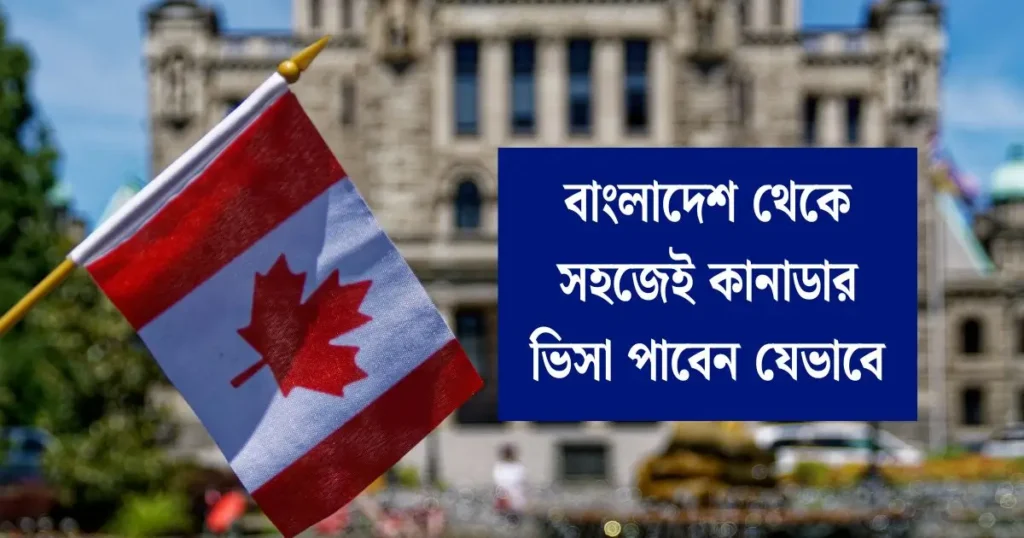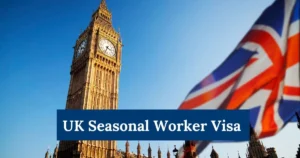Professionals from all over the world, including those from Bangladesh, have long flocked to Canada in search of improved job prospects and a high standard of living.
Canada provides a great environment for skilled people wishing to start their careers overseas because of its strong economy, friendly immigration laws, and cosmopolitan society.
The Canada Work Permit Visa is one of the main avenues via which professionals from Bangladesh can find employment in Canada. For those interested in applying from Bangladesh and other countries, this page offers a comprehensive reference to the Canada Work Permit Visa application procedure for 2024.
Understanding the Canada Work Permit Visa

Foreign people are permitted to work in Canada for a certain employer and period with a document called a Canada Work Permit, which is given by Immigration, Refugees, and Citizenship Canada (IRCC). Employer-specific and open work permits are the two primary categories of work permits.
Work Permit Specific to Employer: With the use of this permit, you are able to work for the company, place, and task that are specified in your work permit.
Available Work Permit: With a few exceptions, you can work for any employer in Canada with this permit as it is not job-specific. Open work permits are usually issued in certain situations, such as for foreign students or spouses of skilled workers.
Getting a work permit is a multi-stage process that needs careful attention to detail and extensive preparation for each step.
Qualifications for a Canada Work Permit
Be sure you fulfill the requirements before applying for a work permit in Canada. The general prerequisites for eligibility consist of:
Offer for Job: An employer in Canada must have extended you a legitimate job offer. Unless you fall under one of the categories where the Labor Market Impact Assessment (LMIA) is exempt, the job offer needs to be supported by a favorable LMIA.
- LMIA: Employment and Social Development Canada (ESDC) issues labor market information agreements (LMIAs), which provide Canadian employers permission to hire overseas workers. The LMIA attests to the fact that no Canadian worker is available for the position and that a foreign worker is required to fill it.
A Proof of Eligibility: It is your responsibility to demonstrate that you are qualified for the position for which you have been selected. These could include degrees from accredited institutions, professional experience, and any licenses that may be needed.
Evidence of Funds: It must be proven that you have sufficient funds to sustain your family and yourself while in Canada and when you go back home.
- Physical and Personal Qualities: You might have to go through a medical examination and need to be in good health. You can also be required to present a police clearance certificate, and you need to have a spotless criminal history.
A Step-by-Step Guide to Applying for a Canada Work Permit Visa
1. Receive a Job Offer from an Employer in Canada
Getting a job offer from a Canadian employer is the first and most important step in the application process for a work permit. The position, pay, and length of work should all be specified in this written job offer.
Employers in Canada are generally open to hiring foreign workers, particularly in fields like IT, healthcare, engineering, and agriculture, where there is a labor shortage.
2. Assessment of the Labor Market Impact (LMIA)
Your Canadian employer might need to get an LMIA from Employment and Social Development Canada (ESDC) once you’ve received a job offer. An important document that proves hiring a foreign worker will help the Canadian labor market is the LMIA.
Exemptions from LMIA Certain employment categories, such as those covered by international accords like NAFTA, positions that greatly benefit Canada, and intra-company transfers, may be exempt from the LMIA requirement.
3. Compile the Necessary Records
You will need to acquire a number of crucial documents in order to apply for a work permit in Canada. Usually, these consist of:
- Valid Passport: Throughout the whole time you are visiting Canada, your passport must remain valid.
- Job Offer Letter: Your Canadian employer’s formal offer of employment.
- A copy of your employer’s positive LMIA, if applicable.
- Copies of your degree transcripts, employment recommendation letters, and any necessary professional licenses serve as proof of qualifications.
- Proof of Financial Support: Payroll letters, bank statements, or other records proving you have enough money.
- Results of Medical Exam: If necessary, you will be subjected to a medical examination by a panel physician who has been approved.
- A police clearance certificate is proof that you have never been convicted of a crime.
4. Send in Your Application
You can file for a work permit once you have acquired all required paperwork. To apply, there are two main methods:
Online Application: Using the IRCC website to submit an application is the most popular and practical option. In order to proceed, you must register, fill out the online forms, upload your supporting documentation, and pay the application fee.
Paper Application: You can mail a paper application to the appropriate Visa Application Center (VAC) if you are unable to apply online. Make sure all paperwork is provided and that the forms are correctly filled out.
Application Fees: A work permit application typically costs CAD 155. For further services and biometrics (CAD 85), there can be additional costs.
5. Biometrics Consultation
You’ll need to submit biometrics (a picture and your fingerprints) after submitting your application.
Should this be the case, you will be given a biometric instruction letter that you must show at an approved collecting location, like an Application Support Center (ASC) or Visa Application Center (VAC). Biometrics are used to verify your identity and improve application process security.
6. Hold Off on Processing
Wait periods for Canada’s processing Applications for work permits can differ based on the sort of work permit you’re requesting and your country of residence. Processing can take a few weeks to several months on average. During this period, you might receive a call from the IRCC asking for more details or to arrange an interview.
Monitoring Your Request: With your IRCC account, This will provide you updates on how your application is being processed and let you know if there are any other actions you need to complete.
7. Get the Verdict
After the IRCC has reviewed your application, you will get a decision. You will obtain a letter of introduction and, if necessary, a visa sticker in your passport if your application is accepted. When you arrive in Canada, you must provide a letter of introduction to a border services officer; it is different from your work permit.
Point of Entry: You will hand over your passport, your letter of introduction, and any other necessary paperwork to a Canada Border Services Agency (CBSA) official upon arrival in the country. Your real work permit, which will contain the terms of your employment in Canada, will be issued by the officer after they have verified your documentation.
Living and Working in Canada Following Approval
You can lawfully work in Canada once you have your work permit, subject to the restrictions outlined in it. You must abide by these terms and restrictions because failing to do so may result in the cancellation of your permission and even deportation.
Renewal of Work Permit: You should apply for a new work permit or an extension if you want to stay longer in Canada or change jobs. You should start this process well in advance of the expiration of your present permit.
Road to Permanent Residency: A lot of foreign employees in Canada decide to apply for permanent residency via the Canadian Experience Class (CEC), the Provincial Nominee Program (PNP), or the Express Entry system. Acquiring job experience in Canada might greatly increase your eligibility for these programs.
Common Challenges and How to Overcome Them
- Delays in LMIA: The lengthy LMIA procedure could cause your application to be delayed. Collaborate closely with your employer to guarantee the earliest possible acquisition of the LMIA.
- Inadequate Records: Applications may be rejected or delayed as a result of missing or inaccurate documentation. Verify each document one more before submitting it.
- Rejection of Application: Applications may be turned down for a number of reasons, including inadequate funding or qualification documentation. If your application is turned down, carefully read the reasons for rejection and think about reapplying once the problems have been resolved.
Latest Pots
- How to Renew a US Visa: A Comprehensive Guide
- UAE Golden Visa Requirements: Are You Eligible?
- How to Apply for a UK Seasonal Worker Visa from Bangladesh: A Complete Guide
Final Thoughts
Professionals from Bangladesh and other professionals who want to grow in one of the most dynamic economies in the world have a bright future ahead of them with the Canada Work Permit Visa application procedure for 2024.
Even though the process can be complicated, following the instructions and being well-prepared will greatly improve your chances of success. Getting a Canada Work Permit is an important step toward reaching your professional objectives, regardless of your plans to work temporarily in Canada or eventually move to permanent residence.




